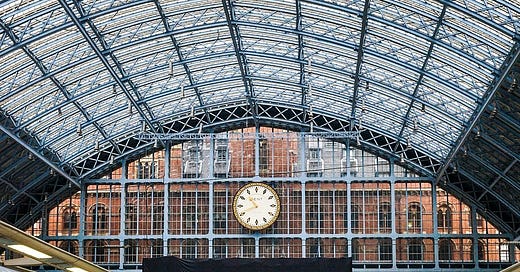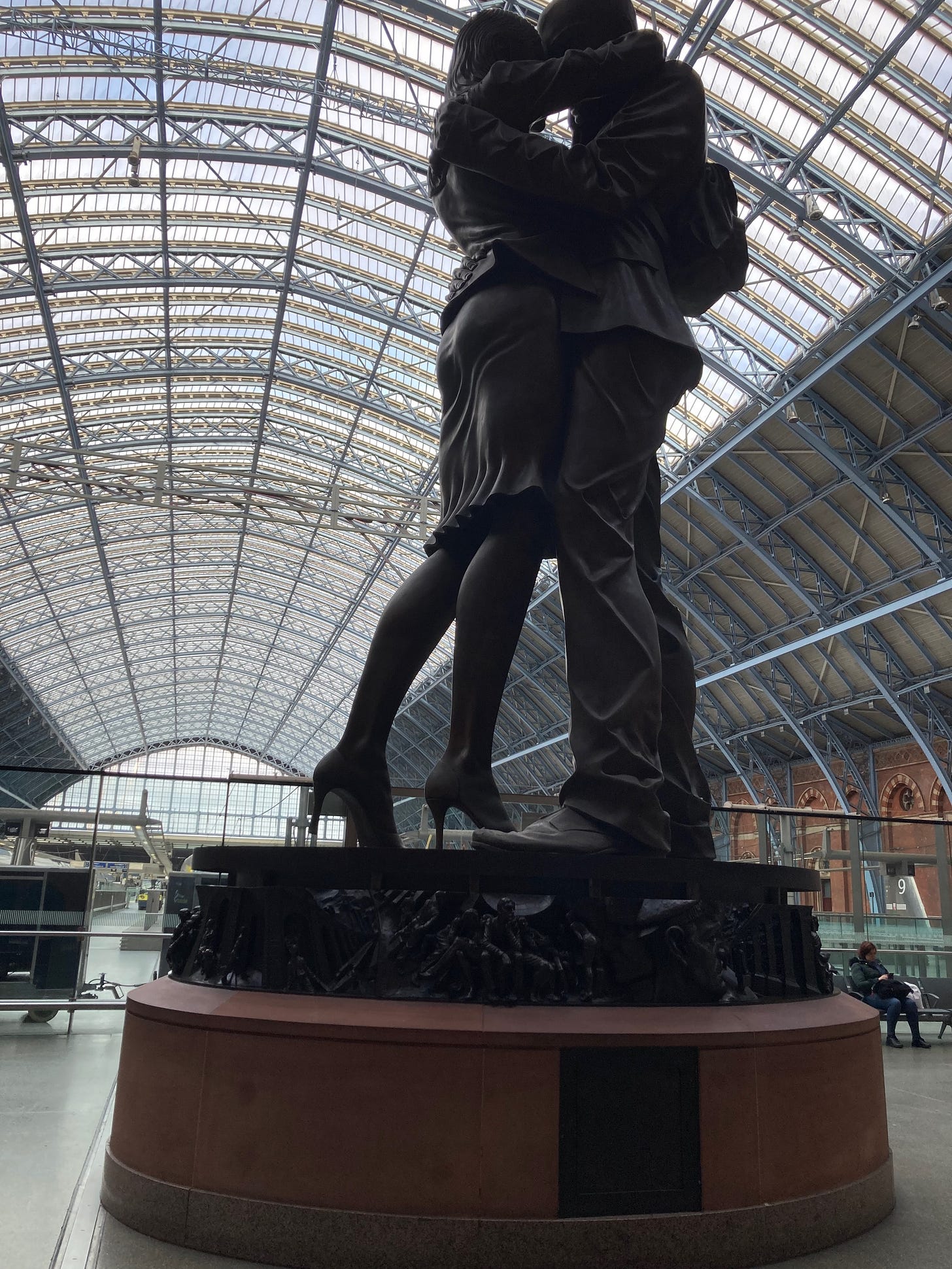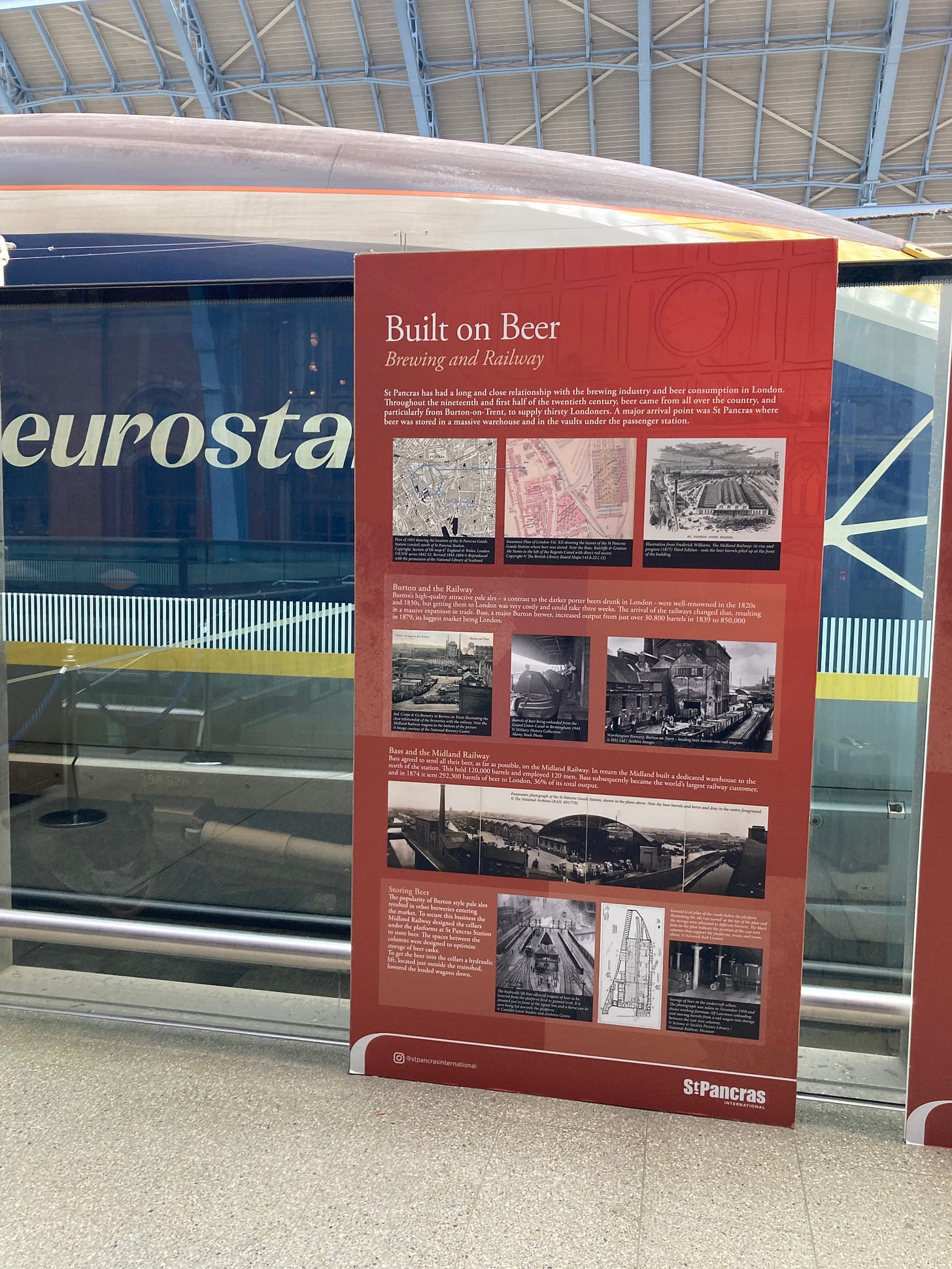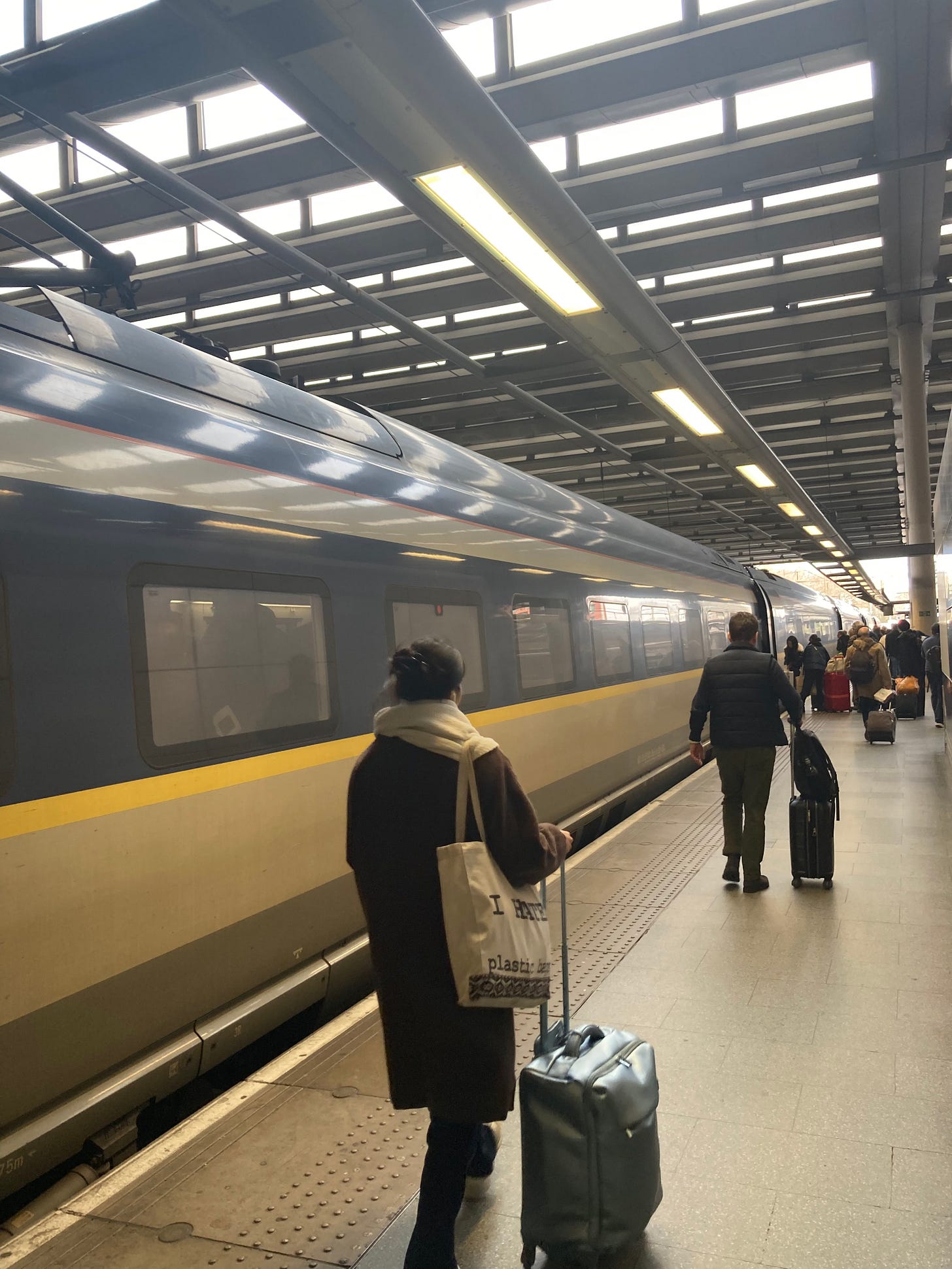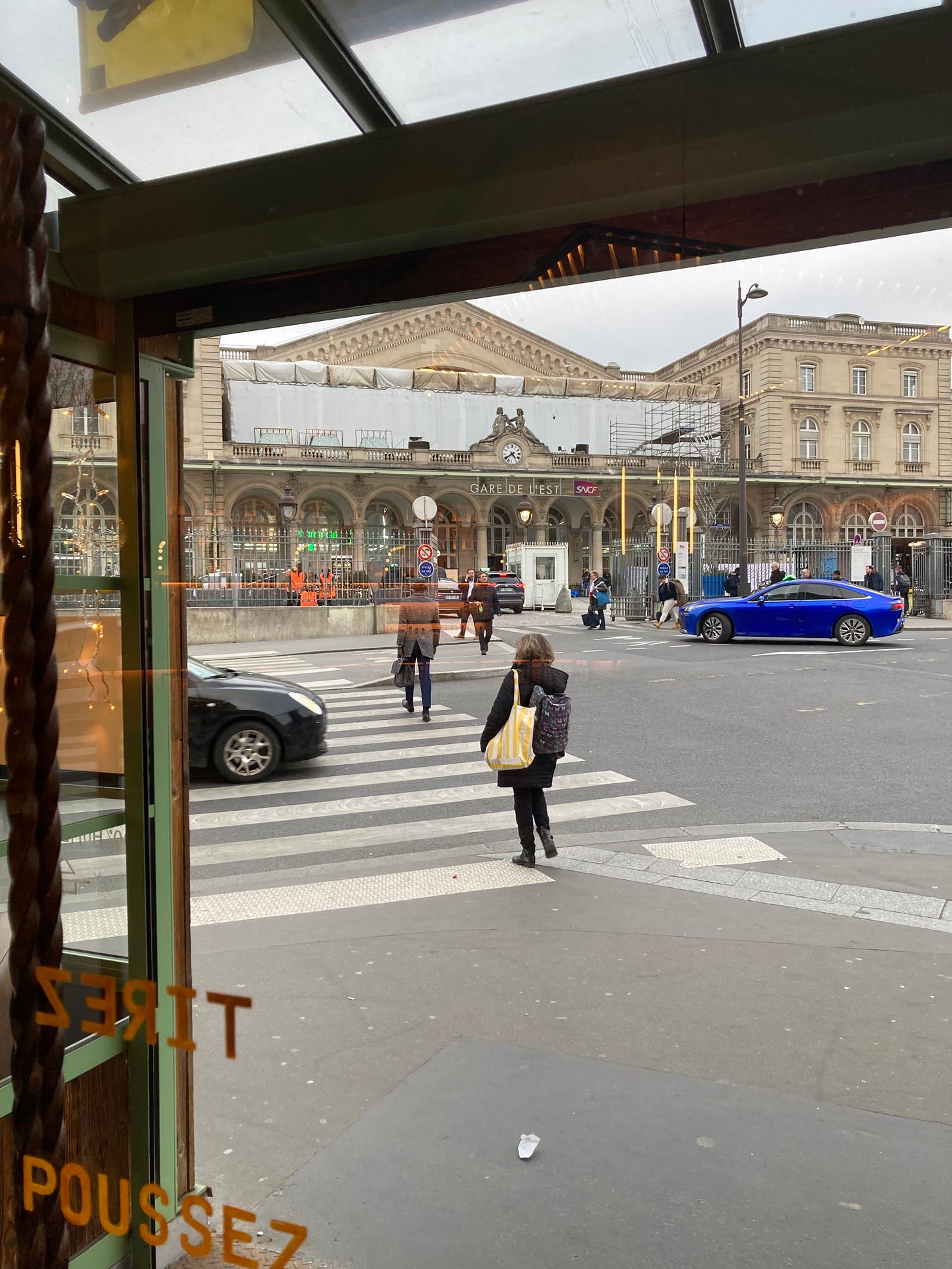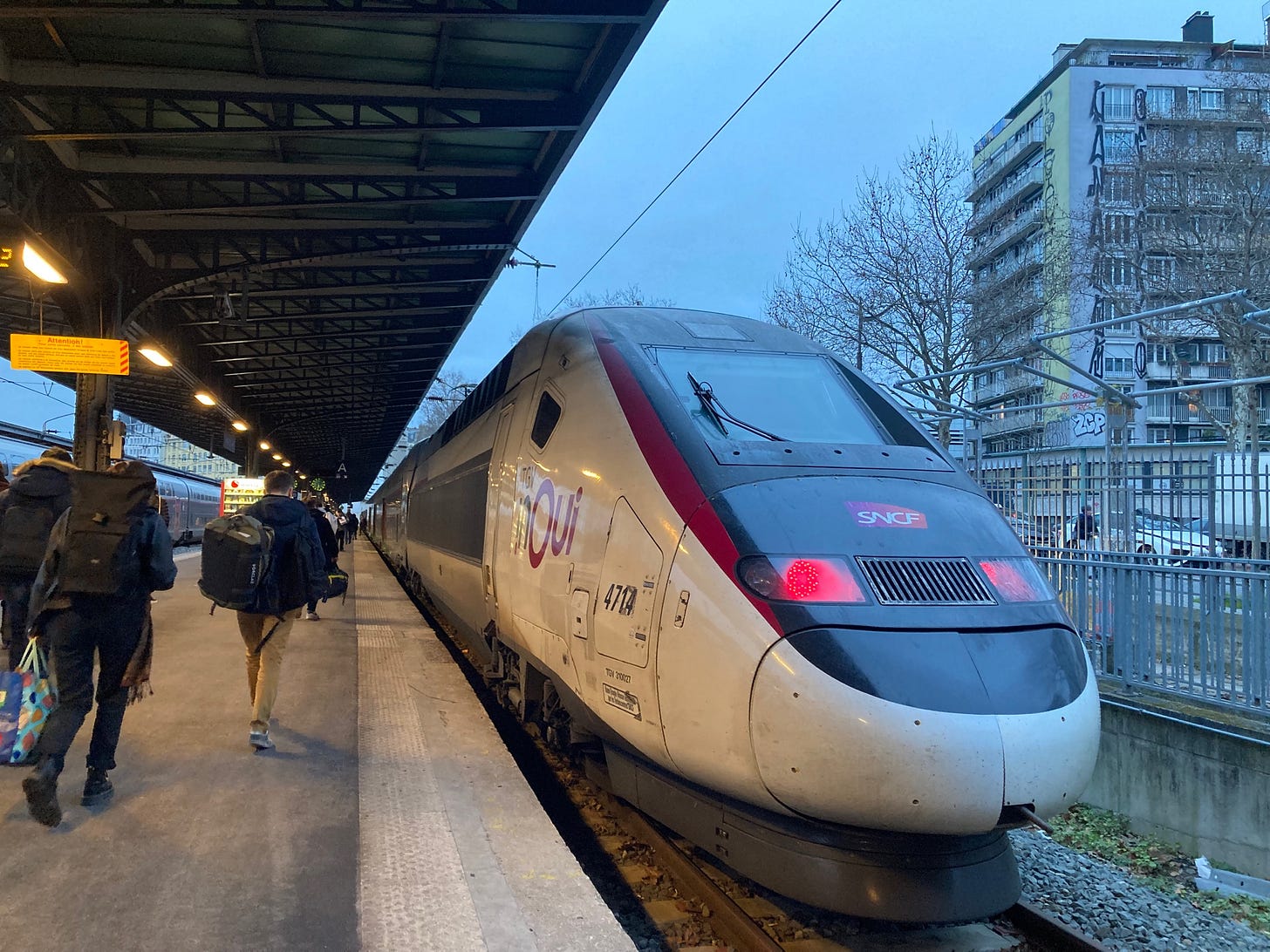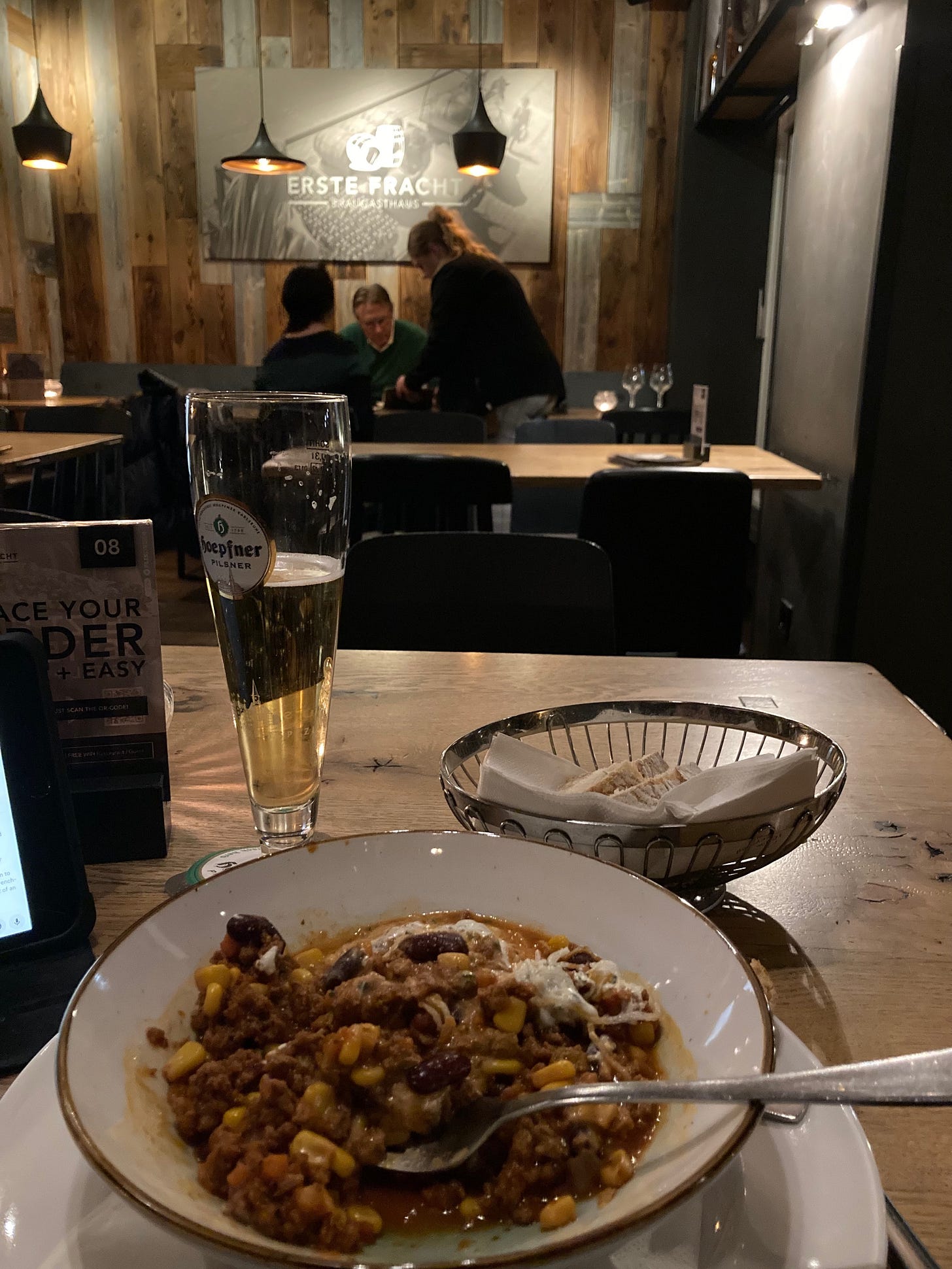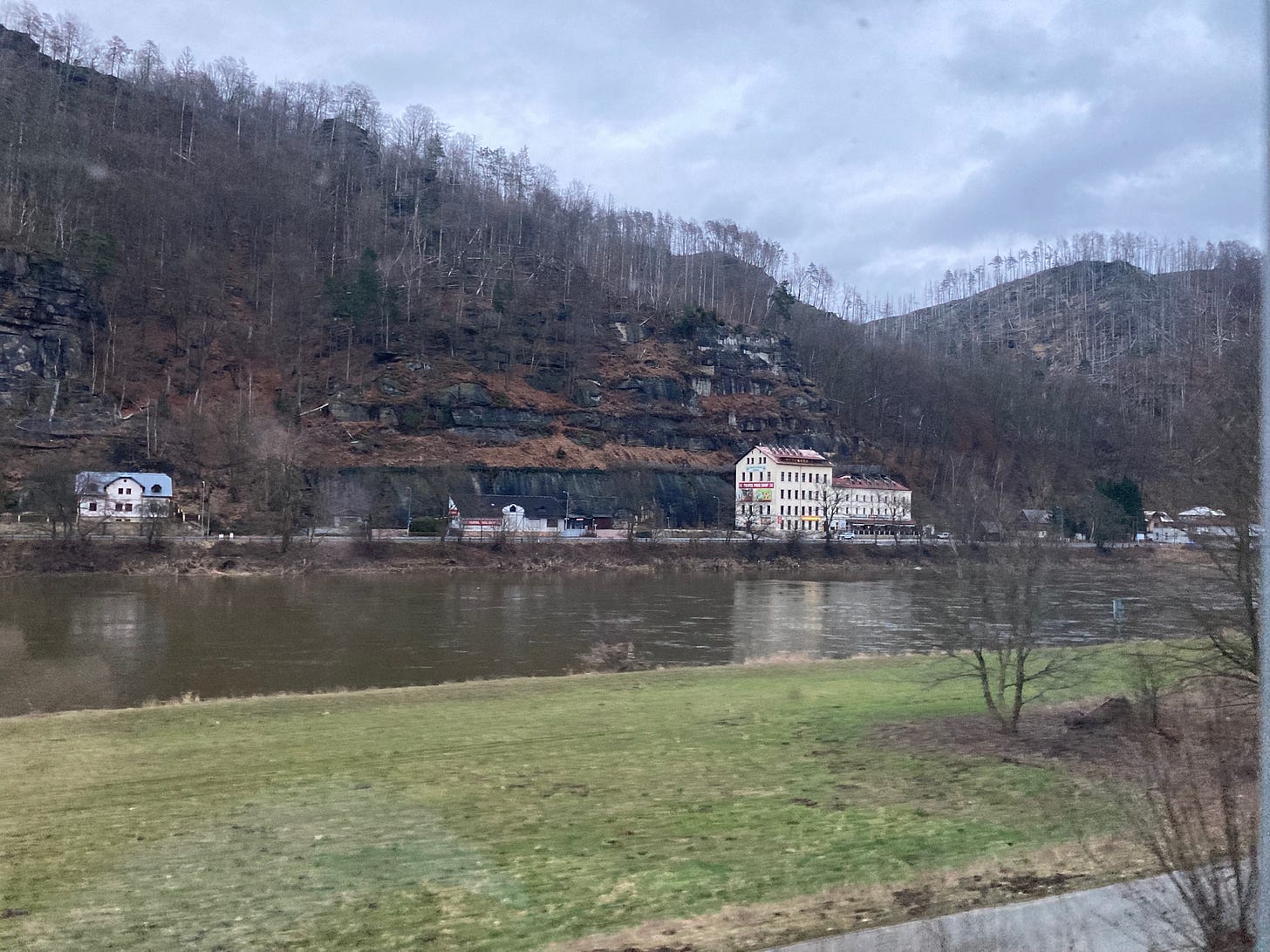Monday 5th February.
It's 9:30 in the morning in Eltham, the south-east London suburb where I grew up. I've been staying with my sister who still lives here and now I'm heading back to Prague. London City airport is just across the river and a British Airways flight is waiting to take me back. The weather is fine and at City Airport flights are usually very punctual. I will be back in Prague soon after lunchtime.
Well I would be; but I am not taking the flight. Instead I am returning by train. I will be back in Prague almost exactly 24 hours from now. Why on earth would I do that?
Of course if I needed to get back to Prague urgently, I would be on the plane, even though it looks like British Airways will not be flying from City much longer, so from April I would have to get across London to Heathrow again; and even though London now has Crossrail (marketed as the Elizabeth Line) making it easier, it is still a very tedious journey. But I have time, and I like travelling by train, so the journey is something I look forward to; I'm looking forward to travelling on Eurostar again; I'm looking forward to stepping out onto the streets of Paris for the short walk between Gare du Nord and Gare de l’Est; I’m looking forward to taking the TGV from Paris to Karlsruhe in first class for a very reasonable price; I'm looking forward to the pub across the road from Karlsruhe station which has been recommended before boarding the night sleeper train to Prague; and I'm looking forward to waking up in the morning by the river Elbe and cruising into Prague on that beautiful riverside line while enjoying breakfast.
Karlsruhe? Why Karlsruhe? It is one of several routes suggested for the London -Prague rail journey by the legendary Man in Seat 61 -and by the way Czech readers, just last week Respekt published an interview with him. Without the Man I would never have realised that those two Paris stations are so close to each other, I would never have spotted the Karlsruhe connection, and I certainly would not have known about the pub in Karlsruhe. He explains all of this on the relevant page of his website. And although I have travelled from London to Prague several times before and know that I will have to buy my tickets on three different websites, most people do not know this and he explains every step in great detail. In his interview with Respekt he deplores the fact that there is no single European website for planning international rail journeys and buying one ticket for the entire journey; he remarks that if such a site existed there would be no need for his own one. But I am not so sure about that. He has actually travelled on most of the routes he describes, and his knowledge and experiences will be invaluable to travellers for many years to come.
As I mentioned in my previous post, before the pandemic I always started my journey on Eurostar at Ebbsfleet station, and I think it is completely unacceptable that Eurostar refuses to open it. But I won't bore you with that any more; after all if you are a visitor to London you will be staying somewhere quite central so St Pancras station would be your logical starting point. I am making my way there now, and I'm pleasantly surprised to find that I can easily get a seat on both my suburban train and tube train. Before the pandemic at this time on a Monday morning it would still have been standing room only.
There has been a lot of coverage in the media of the difficulties of boarding Eurostar trains at St Pancras since Brexit finally happened; this is because the passport controls take longer now. So I have made sure to arrive in plenty of time, 90 minutes before departure time. However this morning I see that it was not necessary, there are no queues and so I follow the recommendation of the Man to go upstairs to admire the architecture of the beautifully reconstructed old station.
The architecture is somewhat spoilt by the sight of the Eurostar trains at the platforms, screened off by heavy glass because the platforms are deemed to be on the other side of the French border.
With mixed feelings I head back towards the Eurostar departure area, pausing to pick up something for lunch at the M&S food store right alongside. Then I walk in, and first comes the “security.” Regrettably it is much like an airport, the one advantage being that you do not have to worry about liquids. But you will have to take off your belt and possibly your watch, depending on the mood of the particular security guard who is hustling you through the vaguely stressful process. It is reasonable to ask why all this is necessary. There are now other tunnels in Europe as long as this one, such as the new Gotthard Base in Switzerland; or the magnificent Oresund Bridge connecting Copenhagen and Malmö - according to some, a hotbed of Islamic terror cells - yet there is no such security there. It is just performative nonsense here, and it is a barrier to further growth for Eurostar or any competitor because any new station on the Continent would be required by the British to put similar measures in place for the return journey.
Then comes the double passport check. Another piece of performative nonsense is requested by Eurostar before you start your journey. You are expected to fill in details about yourself on the website including your passport number. Well, I have two passports now. I gave my UK passport number on the website form. However I decided that I will show my UK passport to the UK control, and my Czech/EU passport to the French control. It is still not busy, and the UK check takes a few seconds. I move onto the French control where I have a choice of three vacant booths. For some unaccountable reason I select the one occupied by a strikingly beautiful black-skinned lady. I greet her with “Bonjour” which she returns with a faint smile. I pull out my passport from the black leather case that I have always used since it was given to me by my Finnish friend back in 1979. On it I have placed a sticker with the EU flag and the legend "Citizen of Europe”. Her eyes fall on that sticker and she considers my Czech passport with some interest before running it through her scanner. It takes a few seconds longer than the British one but she then hands it back. I say “merci” - and she gives me a very big, knowing, smile. I proceed to the Pret for an espresso with a spring in my step.
The departure area at St.Pancras is much criticised for being too small; and on this day there is even a queue for toilets because half of them are being refurbished. But the boarding procedure is OK. I have to say that I do not like the newer e320 Eurostar trains. The high backrests do not actually increase comfort but they definitely create a cramped claustrophobic atmosphere. And I am convinced the windows are smaller than on the e300 trains too. It’s busy, I estimate 80% occupied, at least in my coach and the two I went through to reach the bistro car. However when I booked I noticed that the train scheduled to leave one hour later than this one had been mysteriously removed from the timetable for “operational” reasons, so Eurostar are clearly still limiting capacity.
But it does its main job well. It arrives in Paris Gare du Nord on time. In fact, it arrives 10 minutes early.
Since the border control nonsense all took place in London, we are all free to get off and leave the station like any normal rail passengers. I carefully consult my map app, but it really is simple to walk to Gare de l’Est in 10 minutes, the streets are busy in that very Paris way, but it's not a problem, and it looks like many people are walking between the two stations exactly as I am. And I find that I have arrived in Est station with more than an hour to spare.
So I decide to look outside the station for a café. Across the road there is a parade of buildings and each one contains a restaurant or café. Each of the three offers a distinctively different experience. On the right is a traditional restaurant and relatively expensive. in the middle is something like a working person’s restaurant, and considerably cheaper. On the left is a café which has a lot of young customers with laptops. I go for this one. I think it is the right choice, and they clearly expect rail passengers; there is an electronic departure board for the train services on the wall.
After a nice snack and ginger tea I head back to the station. It is still 30 minutes before departure, but to my pleasant surprise, the TGV is already at the platform and ready to board. It is the start of an experience which is superior to Eurostar in a number of ways. I scan my ticket at the platform entrance and stroll on. I have been able to purchase a first class ticket for a very reasonable €49. Thanks to the Man I know that my seat will be on the upper deck of the double-decker train. The seats are wide and with plush upholstery. There are no high seat backs and the sense of space compared with Eurostar is striking. But I am comparing first class to second class. Then again, it seems like the prices are upside down. I paid €101 for Eurostar but only €49 for the TGV, for a slightly longer journey.
The TGV does its basic job every bit as well as Eurostar. It leaves on time and after about ten minutes is on the high speed line. Unfortunately it is dark outside so the view from my upper deck seat is limited, but the information screen in the coach regularly displays speed information, 310km/hour is a common figure to see. You would not know otherwise that we are travelling so fast, although when the train passes another travelling in the opposite direction you do feel the air collision between them. Our first stop is Strasbourg. This iconic European city sits on the river Rhine; Germany is right across the river. The TGV gets us there in 108 minutes.
After a short pause, we are on the way again across the river and then we turn north. Inevitably the German line is slower, although 250km/h is allowed. In about another 40 minutes we roll into Karlsruhe, and once again, exactly on schedule.
OK, but can he do it on a cold Monday night in Karlsruhe?
When I first read about this route on the Seat 61 website I must admit that waiting three hours in Karlsruhe to board a sleeper train at after 23.00 on a February night did not look like the most attractive proposition; but because he was recommending a pub there, it was clear that the Man had already personally taken this route. I didn't know anything about Karlsruhe - other than very recently learning that it is the home of Germany's Constitutional Court, which has recently been creating some difficulties for the German government. I imagined therefore that outside the station I would find a fairly busy modern centre. This turned out to be quite inaccurate. When I stepped out from the station building, the scene was pleasingly low-rise and very calm. The entire square was devoted to tram and bus-stops, and the trams and buses were very quiet. It appeared that no private cars were allowed in front of the station. My destination, the Erste Fracht Braugasthaus pub was just across the other side of the tram tracks. It could hardly be more convenient. Inside it is quite a large pub decorated in light wood, with several rooms (actually it's a microbrewery of about the same size as Cobolis Ladvi in Prague) and of course on this cold Monday night in Karlsruhe it was pretty empty. But outside the window where I sat there was a very nice looking terrace which was clearly just waiting for Spring. So I can imagine that on a Friday night in May this place will be pretty busy. The service was pleasant and the range of beers very tempting. The two that I tried were very good. The menu had something for everybody; let's describe it as modern German pub food.
I had picked up a sleeper train at this sort of time in the evening before and actually here in Karlsruhe it was a much more pleasant experience than in Cologne – which is too big and can get a bit lively, e.g. on New Year's Eve or when FC Köln have a match; or by contrast in Sargans, which is too small, especially if you get back to the station from a restaurant and find that your train is 40 minutes late. There is nothing to do in Sargans station but sit. As I learnt, Karlsruhe is a modern university city of around 300,000 inhabitants and quite a tech hub. I would quite like to return and spend some more time there.
I was convinced the sleeper train would be on time because it was starting from Switzerland; however my app soon informed me that it was about 15 minutes late. It did manage to reduce the deficit by the time it came in so it wasn't too frustrating standing on the platform – although it was certainly getting a bit cold. This train is branded as an ÖBB NightJet and the first part of the train indeed consisted of NightJet coaches; they would end up next morning in Berlin.
At the back of the train were three České dráhy trains; first the old couchette car, then a standard coach with ordinary seats, and finally the sleeping car. The conductor was Czech and showed me to my cabin, where everything was prepared. Because of the big increase in prices I had not chosen the deluxe compartment with private shower, but you still get a wash basin in all of the compartments. There were two bottles of water and slippers provided. The conductor took me through all the details on how everything works, especially the door locks. You get a key card which opens your door from the outside – and also opens the toilet and shower room at the end of the corridor. But in addition you have two bolt locks which only you can use, from the inside. It really is very secure- although I have never heard of any issues anyway on such trains in Germany, or in the Czech Republic - at least since 20 years ago. The conductor is dedicated to just the sleeping car, and is always available. He also locks the connecting door to the other coaches during the night.
He also agrees with you what time you’d like him to bring your breakfast in the morning. The breakfast is not the best you will have, but I had a plan. When this sleeper train had been introduced, much was made in the media and PR of the restaurant car that would be attached to the train between Leipzig and Prague. But when I asked the conductor about it, he confessed that he was not sure, but that probably there would not be a restaurant car; it was not regular, he said.
This was a bit disappointing, especially as having just checked my latest addition of the European Rail Timetable it definitely should have been provided. I guess that ČD may have withdrawn it until the Spring, when more high-spending foreign travellers will return to fill all its seats.
Never mind; I got into bed. People ask how much sleep they can expect to get on a sleeper train. My answer is that people vary in their ability to sleep in unfamiliar places. I tend to be one of the more fussy types, especially now I'm older. On the train you need to get used to the rhythms and noises. At first I was a bit restless; but after a while I fell into quite a good sleep to be awoken only by the discreet alarm call which the conductor had set up. I switched it off, and without leaving the bed, unlocked the door. In a few minutes he opened the door to deliver my breakfast, setting up a small table for it alongside the bed. I opened the window blind, and we were running beside the river. It took me a little while to work out that this river was already the Labe rather than the Elbe. I was already back in Czechia.
I walked down to the conductor’s cabin to report that he was right about the restaurant car. He gave me a coffee, free of charge. I had a good look at the other compartments; it looked like every one had been occupied but that a lot got out in Germany. I suppose if you are travelling from Basel to Leipzig, it’s still a good idea, if you can sleep early and don’t mind arriving at 04.30.
We arrived in Prague right on schedule. Each of the three trains had been on schedule to the minute. I walked out to the metro feeling quite refreshed, and within half an hour was back home.
So. Should you take the train from Prague to London, (or vice-versa)?
My short answer is, only if you would like to treat the journey as something to enjoy.
The other qualitative reason might be that you wish to choose the train rather than the plane as the more climate friendly option. The problem in this case is that it will probably cost you twice as much to make this good choice.
The cost of my trip was
Eurostar, London-Paris, second class : €101
TGV, Paris-Karlsruhe, first class: : € 49
Sleeper, single occupancy, standard :€ 238
The sleeper price is effectively halved if two people travel together; however Eurostar prices seem set to remain very high, and I doubt that the price I paid for the TGV ticket will be that low as we get into Spring. I only travel by British Airways on the London-Prague route but it will not be hard to find an air ticket with one of the low-cost airlines for €70.
You might need or want to stop off at one of the cities on the route, e.g Strasbourg. In that case, the train becomes a more rational competitor to the plane.
But I did it for fun. Instead of being stuck in a pressurised tube above Europe for 90 minutes, in between two fairly unpleasant shuttles to and from fairly unpleasant airports, I get to see Europe, to hear it, to feel the differences as I travel across it. Going to and from London, it reminds me that Britain is still physically connected to Europe by that tunnel, that it really is so close, and that we do have so much in common. I experienced a little bit of Paris, and a new German city.
The launch of the new European Sleeper service from Brussels to Prague on March 25th will bring a very interesting new choice. Instead of three trains, you will need only two to get you to and from London, and the Eurostar journey from London to Brussels is shorter and often cheaper than to Paris. It is not going to be perfect; because it runs to Amsterdam en route to Berlin and Prague, you are on the train for quite a long time, and the sleeping car is a quite old vehicle, so i will be interested to read early reports from travellers. But it is a brave and enterprising new service from a crowd-funded cooperative company; I am actually one of the small shareholders, so I certainly want it to succeed – even if I might decide that the TGV to the pub in Karlsruhe was such fun that I want to do it again! It's nice to have the choice, because both options are clearly better than going via Zürich.
There is no point in hiding the truth; the train from London to Prague is too expensive, and far more difficult to buy than it should be. The plane should be more expensive too - kerosene is the only fuel that is not taxed. Yet its clear the demand for night trains in Europe is really growing and other operators are working hard to provide the same quality of service as the NightJets. And you are certainly helping the planet by choosing the train- and as your journey unfolds, and you rush across borders with only the annoying texts from your phone provider to inform you, you may start to think of the railways as the arteries of the European continent. And when every train on a journey from Eltham in London’s south-east suburbs to Prague arrives on time, you might conclude that the arteries are in good condition!
The Rail Advocate’s tips
London’s long awaited Elizabeth line is now fully operational and London - wide tickets are fully valid on it. If you are travelling to/from Heathrow, use it rather than the over-priced Heathrow Express. However (in typical British style) it runs near to but not through St. Pancras so for Eurostar the Tube may be a better option depending on where you are heading. Also in typical British style, the brand new Elizabeth trains don’t have toilets 🙁
Eurostar’s bistro car offers some small meals but if you are travelling from St Pancras you’ll be much better off getting something nice from the M&S Just Food store just to the right of check-in area.
This is the mini-brewery in Karlsruhe
If you want to know whether the restaurant car is available with the night train, consult this page on VagonWeb before you book.
Book early!

